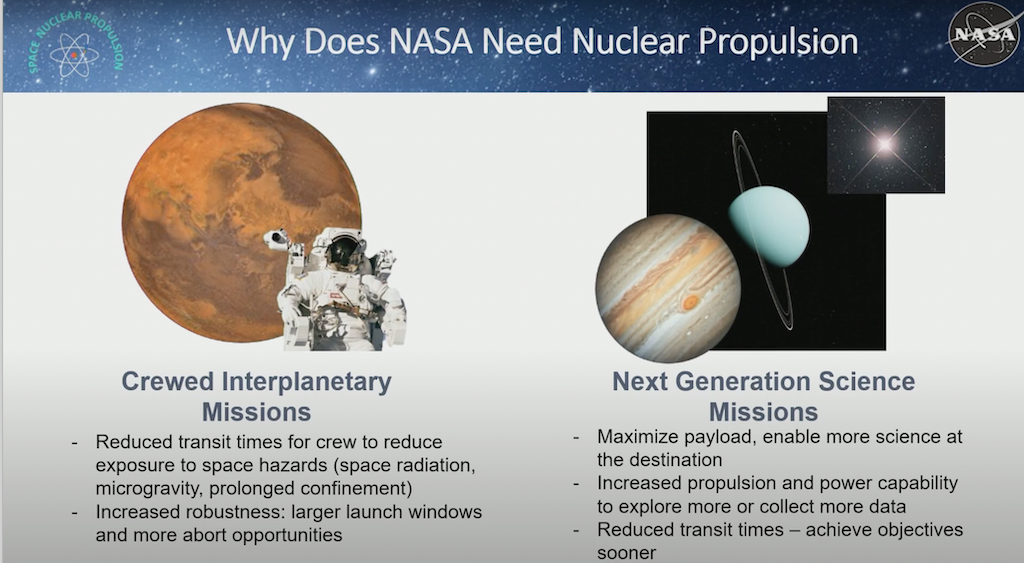by Christophe Bosquillon

The 2023 edition of the legendary von Braun Space Exploration Symposium took place on October 25-27 2023 in the regular location, Huntsville, Alabama (recordings of sessions are available here). Its focus however was interestingly unusual: “Advancing Space: from LEO to Lunar and Beyond” featured a diverse program covering commercial, policy, and strategic communication concerns. Because the von Braun Symposium is certainly focused on the US, it moved across the spectrum of LEO, cislunar, and lunar activities all the way to Mars. Featuring NASA’s technological splendor and mission management prowess, panelists acknowledged they grapple with the growing pains of a governmental organization that keeps learning how to best deal with the commercialization of space. Of particular interest was a session featuring the economic significance of nuclear propulsion in space.
The economic significance of nuclear propulsion in space
The 55 minutes session “Pushing the Limits: Advances in Propulsion” was moderated by Mary Beth Koelbl, Director, Engineering Directorate, NASA MSFC. It featured 5 panelists: Doug Bradley, Program Manager, SLS RS-25, Aerojet Rocketdyne ; Tabitha Dodson, Program Manager, DARPA DRACO ; Mark Fisher, Program Manager, New Glenn BE-4 Main Engine, Blue Origin ; Eric Paulson, Program Manager, Rotating Detonation Rocket Engine, Air Force Research Laboratory ; and Jason Turpin, Senior Technical Leader of Propulsion, NASA MSFC.
Thirty minutes into the discussion Jason Turpin, Senior Technical Leader of Propulsion, NASA MSFC, provided a rationale of why and how NASA is involved in nuclear propulsion development. Turpin argued that, while sawed-off propulsion engines are currently the most powerful, nuclear propulsion has the potential to provide even higher performance and enable robust and enduring access throughout the solar system. Nuclear energy has the capability to provide high power levels for long periods of time, on the contrary of solar power which can’t sustain the kind of propulsion you need past Mars. Nuclear propulsions systems thus could reduce trip times to Mars by up to half the time.
But the relevance of nuclear propulsion starts as close to home as cislunar space, with the DARPA project known as DRACO for “Demonstration Rocket for Agile Cislunar Operations“. Beyond the Moon, NASA’s techno-economic rationale is clear: nuclear propulsion will enable crewed interplanetary missions to reduce transit times and human exposure to space hazards (radiation, microgravity, prolonged confinement). It will also increase robustness, with larger launch windows and more abort opportunities. Next generation science missions that use nuclear propulsion will maximize payload and enable more science at the destination. With reduced transit times followed by increased propulsion and power capability to explore more or collect more data, NASA will achieve objectives sooner.
There are two ways that can be achieved:
– Nuclear Thermal Propulsion (NTP): nuclear fission is a thermal power source, the reactor acts as a heat exchanger for high efficiency, high thrust applications, for long or short duration missions.
– Nuclear Electric Propulsion (NEP): nuclear fission is a thermal power source which is converted to electricity to power electric propulsion thrusters to enable fast transit to far away destinations.
The limitations of both in space missions boil down to the fact that thermal propulsion with high thrust can last up to 900 seconds and achieve a specific impulse (ISP) of 300 seconds. However, with electric propulsion, while the thrust level may decrease, the efficiency increases, enabling longer missions of up to 2,000 seconds ISP. But, to achieve this efficiency, it is necessary to convert thermonuclear power to electrical power, and, ultimately, to thrust. NASA has a technology maturation plan to invest in the necessary component capability and subdisciplines for nuclear electric propulsion in space missions. Turpin’s pitch clearly emphasized the need for a more advanced mindset and innovative design to push the limits of nuclear propulsion and make it an economically sustainable option for future space missions.
DARPA and the DRACO program
As previously mentioned, DARPA is involved in nuclear propulsion. The primary objective of the demo is to perform criticality experiments with a nuclear thermal rocket before starting the engine. The reactor will be brought to a state of criticality and data collected to determine mission success. Once mission success is declared, the flight software will be updated and an engine startup attempted. The program is set to launch in March 2027 from Cape Canaveral, with the main element of the engine being a high-assay, low-enriched uranium reactor. NASA Marshall is also pursuing nuclear propulsion advances to support the DRACO program, and has previously worked on multiple oxidizer stage combustion class engines over the years, supporting various companies.
Challenges and solutions
Space nuclear propulsion is itself part of a larger problematic of engineering techno-economically competitive space propulsion solutions. The session focused first on the Artemis program, that is rebuilding the RS25 engines previously used on the space shuttle. Next, the panelists discussed their experience with additive manufacturing, to reduce cycle time for hardware production. Blue Origin provided insights in their B4 booster engine design for Vulcan. We learned that the Edwards Air Force Base, (and ultimately the US Space Force) is active in rotating detonation combustion.
The discussion on the challenges in maturing nuclear propulsion technology and systems integration focused on achieving faster results in propulsion, model validation, and partnerships with NASA and the Space Force, while not cutting corners to address safety. Space Launch System and Blue Origin engineers are implementing Value Stream Mapping (VSM) and improving manufacturing processes to achieve reliability, performance, flexibility, and affordability, furthering American space transportation economic competitiveness. Blue Origin’s Vulcan, New Glenn’s launch variant that has two engines in the first stage, is designed to reuse engines of the same design. And Marshall Space Flight Center is currently developing nuclear electric propulsion, emphasizing power generation and conversion.
Both China and Europe are looking into space nuclear propulsion. The techno-economic cooperation matrix civilian-military + government-commercial confers an early start to the US. The speed and reliability of space nuclear propulsion will provide an economic competitive edge to the US in space exploration and resources utilization. And it will secure the required flexibility for US Space Force to defend US space assets.
If you want to explore nuclear propulsion more in depth check out our Space Café Radio with the Neutron Star System team

Christophe Bosquillon has a diverse professional background, having operated globally with a focus on the Indo-Pacific region. His experiences in Japan, the Koreas, Taiwan, China, ASEAN, India, Russia, and Australia have given him a deep understanding of the multipolar realpolitik of our world under the Pax Americana. With a background in engineering, trade, and foreign direct investment in industries relevant to Space Resource Utilization (SRU), such as mining, transportation, energy, manufacturing, agrifood, environment, and digitalization, Chris is committed to developing SRU value chains that benefit the Earth. As an executive, owner, writer, and founder of Autonomous Space Futures Ltd, Chris has extensive experience in collaborative policy crafting and works to develop space business and governance models relevant to society. He is a member of NGOs that provide input to the United Nations Committee on the Peaceful Uses of Outer Space (UNCOPUOS) legal subcommittee Working Group on Space Resources. Chris contributes to regulatory clarity on appropriation, priority, sustainability, and sharing in a way that balances national interests with civil society inclusion, provided a transparent due process is followed. When advocating for access to technology and space for the Global South, Chris believes that emerging space powers’ participation in space markets must be commensurate with their interest and involvement in international space politics. He believes that their ability to develop sovereign domestic capabilities with spillover potential is also essential. Chris is keen on ‘Peace Through Strength’ diplomacy and deterrence-based security as enablers of secure space access. He supports sovereign cislunar space situational awareness as mandatory for freedom of circulation in the space domain and deconflicted cooperation on the Moon.
 SpaceWatch.Global An independent perspective on space
SpaceWatch.Global An independent perspective on space




